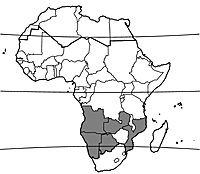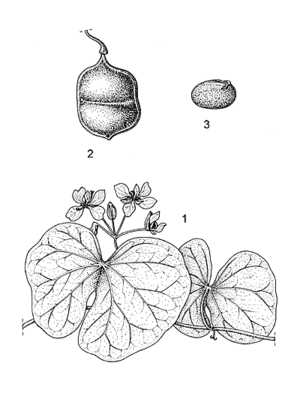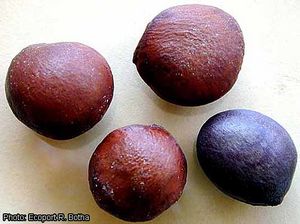Tylosema esculentum (PROTA)
Introduction |
| General importance | |
| Geographic coverage Africa | |
| Geographic coverage World | |
| Cereal / pulse | |
| Carbohydrate / starch | |
| Medicinal | |
| Ornamental | |
| Forage / feed | |
| Food security | |
Tylosema esculentum (Burch.) Schreib.
- Protologue: Mitt. Bot. Staatssamml. München 3: 611 (1960).
- Family: Caesalpiniaceae (Leguminosae - Caesalpinioideae)
- Chromosome number:
Synonyms
- Bauhinia esculenta Burch. (1824).
Vernacular names
- Marama bean, morama bean, gemsbok bean, camel’s foot (En).
- Marama (Fr).
Origin and geographic distribution
Marama bean is native to the Kalahari desert and neighbouring sandy regions in Angola, Namibia, Botswana and South Africa, but it also occurs in Zambia and Mozambique. Experimental cultivation in Kenya, South Africa, Australia, Israel and the United States (Texas) has been successful.
Uses
Marama bean is an important part of the diet of the Khoisan people in the Kalahari, where subsistence agriculture is marginal due to drought and low soil fertility, and it is a delicacy among other peoples in southern Africa. The seeds are eaten boiled or roasted. They may be boiled with maize meal or ground into flour to prepare a porridge or a coffee- or cocoa-like drink. Roasted seeds are sometimes sold locally but only on a small scale. Marama beans have a pleasant sweet flavour when boiled or roasted, comparable to roasted cashew nuts or almonds, although bitter types are known. The roasted seeds have sometimes been used by Europeans in southern Africa as a culinary substitute for almonds. Immature seeds and stems may be eaten cooked as a vegetable or in soups. The seed oil is used in Botswana for cooking and for making butter. Young tubers are eaten baked, boiled or roasted, as a vegetable dish. Tubers older than 2 years become fibrous and bitter and are usually not eaten, but they are an important emergency source of water for humans and animals. The pods and tubers are recorded to be eaten by animals, but it is not clear whether the foliage is browsed, as contradictory reports exist. Marama bean may have potential as a ground cover or ornamental.
Properties
Mature, shelled marama bean seeds contain per 100 g: water 3.9 g, energy 2660 kJ (635 kcal), protein 31.8 g, fat 42.2 g and carbohydrate 18.9 g (Bower et al., 1988). The protein content of marama bean is comparable to that of soya bean, and the oil content is twice as high as that of soya bean and comparable to that of groundnut. The essential amino-acid composition per 100 g food is: tryptophan 219 mg, lysine 1119 mg, methionine 257 mg, phenylalanine 874 mg, threonine 822 mg, valine 1149 mg, leucine 1774 mg and isoleucine 1119 mg (FAO, 1970). The seeds have a relatively high trypsin inhibitor activity, which can be remedied by cooking. The seed oil is golden-yellow, with a nutty odour and a pleasant, although slightly bitter flavour, and has been described as similar to almond oil in consistency and taste. Its principal fatty acids are oleic acid (48–49%), linoleic acid (19–26%), palmitic acid (12–14%), stearic acid (7–10%) and arachidic acid (3%). Per 100 g dry weight the defatted seed meal contains: energy 194 kJ (46 kcal), protein 55.0 g, available starch 13.0 g and fibre 1.6 g. Per 100 g, the tubers of a 5- month-old plant contain: water 92.1 g, protein 2.1 g, fat 0.1 g and carbohydrate 4.4 g. Young tubers have a sweet and pleasant taste and the texture has been described as similar to that of artichoke. The tubers are reddish when dried.
Description
- Perennial herb or shrub, with tuberous root; stems prostrate and trailing, up to 6 m long, herbaceous or lower parts woody, rusty-hairy, with axillary forked tendrils 1–4 cm long.
- Leaves alternate, simple; stipules 3–5 mm × 2–3 mm; petiole 1.5–3.5 cm long; blade 2-lobed for more than half its length, glabrous or pubescent beneath; lobes reniform, 3.5–5 cm × 5–6.5 cm.
- Inflorescence a lateral raceme up to 16 cm long; peduncle 2–4 cm long.
- Flowers bisexual, zygomorphic, 5-merous, heterostylous; pedicel 2–4.5 cm long; sepals free but upper 2 fused, 8–12 mm × 2–3 mm, rusty-hairy; petals unequal, 4 larger ones 1.5–2.5 cm × 1–1.5 cm and tapering into a basal claw, the upper one smaller, yellow turning reddish with age; stamens 2, free, with filaments 6–12 mm long, staminodes 8, with filaments 3–6 mm long; ovary superior, 5–6 mm long, 1-celled, style elongate, stigma small.
- Fruit an ovoid to oblong pod 3.5–6 cm × 3–4 cm, flattened, woody, 1–2(–6)-seeded, constricted between the seeds.
- Seeds ovoid to globose, 1.3–2.5 cm × 1.2–1.5 cm, reddish to brownish black.
Other botanical information
Tylosema comprises 5 species and occurs in southern and eastern Africa. Some taxonomists do not consider Tylosema a separate genus, but include it in Bauhinia. Tylosema fassoglense (Schweinf.) Torre & Hillc., which also has edible seeds and tubers, has longer leaf stalks and more shallowly lobed leaves.
Growth and development
In field experiments in Kenya marama bean seeds started to germinate 9–10 days after planting. Once germinated the seedlings develop rapidly. Marama bean has been recorded as not flowering until the 3rd or 4th year after planting, but in experiments in Texas plants started flowering after 2 years, and fruits and seeds were formed after 3.5 years. In its native area marama bean flowers from October to March. It is predominantly outcrossing and may be self-incompatible; it is pollinated by insects. In cultivation fruit and seed set tend to be low. In southern Africa the stems die back during the dry and cool period (May–August), but the tuber remains viable and produces new stems when the temperature rises. Marama bean does not form root nodules and relies on soil nitrogen. Its drought-adaptive mechanisms include closure of leaves, the maintenance of green-leaf area under drought by early stomatal closure, and the use of moisture reserves in the tuber (which shrinks greatly in dry years). Marama bean plants have long trailing stems that creep along the ground and avoid the effects of the strong destructive windstorms of the Kalahari.
Ecology
Marama bean occurs naturally in an extreme environment with high temperatures (typical daily maximum of 37°C in the growing season), low rainfall (100–900 mm) and long periods of drought. It is found on sandy and limestone (including dolomite) soils, but not on soils developed over granite or basalt. Marama bean is found in grassland and wooded grassland vegetation. It occurs in localized patches.
Propagation and planting
Propagation of marama bean is by seed. Germination is sometimes said to be improved by scarification. Soaking will kill the seed and it should not be sown in waterlogged soils. The 1000-seed weight is 2–3 kg. Preliminary results under laboratory conditions show that vegetative propagation using sprouts is possible.
Harvesting
The seeds of marama bean are collected in its native area from the wild and by hand. The tubers are harvested by hand-digging when they weigh about 1 kg.
Yield
In the Kalahari young tubers of marama bean of 1 year old and about 1 kg in weight are preferred. Tubers may reach 10 kg after a few years and tuber weights of up to 300 kg have been reported; a tuber weighing 277 kg contained 224 l water. Information on seed yields of marama bean is not available.
Handling after harvest
Raw seeds of marama bean store well and remain edible for years. Dry storage is preferable. Oil can be extracted from the seeds by conventional pressing or solvent extraction. To obtain water from the tuber, the skin is scraped away and a hole is made. The flesh in and around the hole is mashed with a wooden stick until the consistency is porridge-like. This porridge is put into a piece of fabric and the water is squeezed out with both hands. The water can also be extracted from the tubers by pounding pieces of it in a container.
Genetic resources
Marama bean is considered neither rare nor threatened. No substantial germplasm collections are known to exist. The International Livestock Research Institute (ILRI), Addis Ababa, Ethiopia, the National Genebank, Muguga, Kenya, and the Plant Genetic Resources Unit of the Agricultural Research Council, Pretoria, South Africa, have 1 accession each. Marama bean shows orthodox seed storage behaviour.
Breeding
Programmes for selection and breeding work of marama bean are recorded to be underway in the United States, Australia and Israel. RAPD analysis of 3 populations from various parts of Botswana has shown that a considerable amount of genetic variation exists within marama bean, most of it within rather than between populations. Sufficient genetic variation for breeding may be found by sampling 30–40 plants from 1 or 2 populations.
Prospects
Marama bean is regarded as having considerable potential as a crop for arid and semi-arid regions, and it is being investigated in Australia, Israel and the United States (Texas). It has potential for its roasted seeds and as a source of oil. However, before large-scale cultivation can be promoted, more information is needed on its ecological requirements, adaptability to cultivation and agronomy. Furthermore, genetic improvement and germplasm collection need attention and research should be carried out on the presence of toxic constituents or antinutritional factors in the seeds and tubers.
Major references
- Bower, N., Hertel, K., Oh, J. & Storey, R., 1988. Nutritional evaluation of marama bean (Tylosema esculentum, Fabaceae): analysis of the seed. Economic Botany 42(4): 533–540.
- Dakora, F.D., Lawlor, D.W. & Sibuga, K.P., 1999. Assessment of symbiotic nitrogen nutrition in marama bean (Tylosema esculentum L.) a tuber-producing underutilized African grain legume. Symbiosis 27: 269–277.
- Keegan, A.B. & van Staden, J., 1981. Marama bean, Tylosema esculentum, a plant worthy of cultivation. South African Journal of Science 77: 387.
- Ladizinsky, G. & Smartt, J., 2000. Opportunities for improved adaptation via further domestication. In: Knight, R. (Editor). Linking research and marketing opportunities for pulses in the 21st Century. Kluwer Academic Publishers, Dordrecht, Netherlands. pp 257–263.
- Monaghan, B.G. & Halloran, G.M., 1996. RAPD variation within and between natural populations of morama (Tylosema esculentum (Burchell) Schreiber) in southern Africa. South African Journal of Botany 62(6): 287–291.
- National Academy of Sciences, 1979. Tropical legumes: resources for the future. National Academy of Sciences, Washington, D.C., United States. 331 pp.
- Powell, A.M., 1987. Marama bean (Tylosema esculentum, Fabaceae) seed crop in Texas. Economic Botany 41: 216–220.
- Ross, J.H., 1977. Fabaceae, subfamily Caesalpinioideae. In: Ross, J.H. (Editor). Flora of southern Africa. Volume 16, part 2. Botanical Research Institute, Department of Agricultural Technical Services, Pretoria, South Africa. 142 pp.
- van Wyk, B.E. & Gericke, N., 2000. People’s plants: a guide to useful plants of southern Africa. Briza Publications, Pretoria, South Africa. 351 pp.
- Wickens, G.E., 1998. Ecophysiology of economic plants in arid and semi-arid lands. Springer Verlag, Berlin, Germany. 343 pp.
Other references
- Brummitt, R.K. & Ross, J.H., 1976. A note on Tylosema (Leguminosae - Caesalpinioideae) from southern Africa. Kew Bulletin 31(2): 219–220.
- Chandel, K.P.S. & Singh, B.M., 1984. Some of our under-utilized plants. Indian Farming 34(2): 23–29.
- FAO, 1970. Amino-acid content of foods and biological data on proteins. FAO Nutrition Studies No 24, Rome, Italy. 285 pp.
- Francis, C.M. & Campbell, M.C., 2003. New high quality oil seed crops for temperate and tropical Australia. Rural Industries Research & Development Corporation Publication No 03/045. RIRDC, Canberra, Australia. 27 pp.
- Graham, P.H. & Vance, C.P., 2003. Legumes: importance and constraints to greater use. Plant Physiology 131: 872–877.
- Hao Gang, Zhang, D.X., Zhang, M.Y., Guo, L.X. & Li, S.J., 2003. Phylogenetics of Bauhinia subgenus Phanera (Leguminosae: Caesalpinioideae) based on ITS sequences of nuclear ribosomal DNA. Botanical Bulletin of Academia Sinica Taipei 44(3): 223–228.
- Hartley, M.L., Tshamekeng, E. & Thomas, S.M., 2002. Functional heterostyly in Tylosema esculentum (Caesalpinioideae). Annals of Botany 89: 67–76.
- Hornetz, B., 1993. On the development and acceptance of agropastoral (agrosilvipastoral) systems in the semiarid areas of northern Kenya. In: Baum, E., Wolff, P. & Zöbisch, M.A. (Editors). Acceptance of soil and water conservation strategies and technologies. Topics in applied resource management in the tropics. Volume 3. pp. 413–453.
- ILDIS, 2002. World database of Legumes, Version 6,05. International Legume Database & Information Service. [Internet] http://www.ildis.org/. April 2004.
- IPGRI, undated. Directory of Germplasm Collections. [Internet] http://www.ipgri.cgiar.org. April 2004.
- Keith, M.E. & Renew, R., 1975. Notes on some edible wild plants found in the Kalahari. Koedoe 18: 1–12.
- Ketshajwang, K.K., Holmback, J. & Yeboah, S.O., 1998. Quality and compositional studies of some edible Leguminosae seed oils in Botswana. Journal of the American Oil Chemists Society 75(6): 741–743.
- Leger, S., 1997. The hidden gifts of nature: A description of today’s use of plants in West Bushmanland (Namibia). [Internet] DED, German Development Service, Windhoek, Namibia & Berlin, Germany. http://www.sigridleger.de/book/. April 2004.
- Lock, J.M., 1989. Legumes of Africa: a check-list. Royal Botanic Gardens, Kew, Richmond, United Kingdom. 619 pp.
- Mitchell, R.A.C., Keys, A.J., Gong, Y.-H. & Lawlor, D.W., 2003. Photosynthetic nitrogen and water-use efficiency of marama bean, Tylosema esculentum, an African legume. Comparative Biochemistry and Physiology Part A 134: s166.
- Schreiber, A., 1967. Caesalpiniaceae. Prodromus einer Flora von Südwestafrika. No 59. J. Cramer, Germany. 20 pp.
- USDA, ARS & National Genetic Resources Program, 2001. Germplasm Resources Information Network - (GRIN). [Internet] National Germplasm Resources Laboratory, Beltsville, Maryland, United States. http://www.ars-grin.gov/. April 2004.
- Victor, J.E., undated. Tylosema esculentum (Burch.) Schreiber. [Internet] FAO Crop and Grassland Service (AGPC), Rome, Italy. http://www.fao.o g/ag/AGP/AGPC/doc/GBASE/Safricadata/tylesc.htm. June 2004.
- Vietmeyer, N.D., 1978. The plight of the humble crops. Ceres 11(2): 23–27.
- Watt, J.M. & Breyer-Brandwijk, M.G., 1962. The medicinal and poisonous plants of southern and eastern Africa. 2nd Edition. E. and S. Livingstone, London, United Kingdom. 1457 pp.
Sources of illustration
- Powell, A.M., 1987. Marama bean (Tylosema esculentum, Fabaceae) seed crop in Texas. Economic Botany 41: 216–220.
Author(s)
- L.J.G. van der Maesen, Biosystematics Group, Wageningen University, Gen. Foulkesweg 37, 6703 BL Wageningen, Netherlands
Correct citation of this article
van der Maesen, L.J.G., 2006. Tylosema esculentum (Burch.) A.Schreib. In: Brink, M. & Belay, G. (Editors). PROTA (Plant Resources of Tropical Africa / Ressources végétales de l’Afrique tropicale), Wageningen, Netherlands. Accessed 18 December 2024.
- See the Prota4U database.



